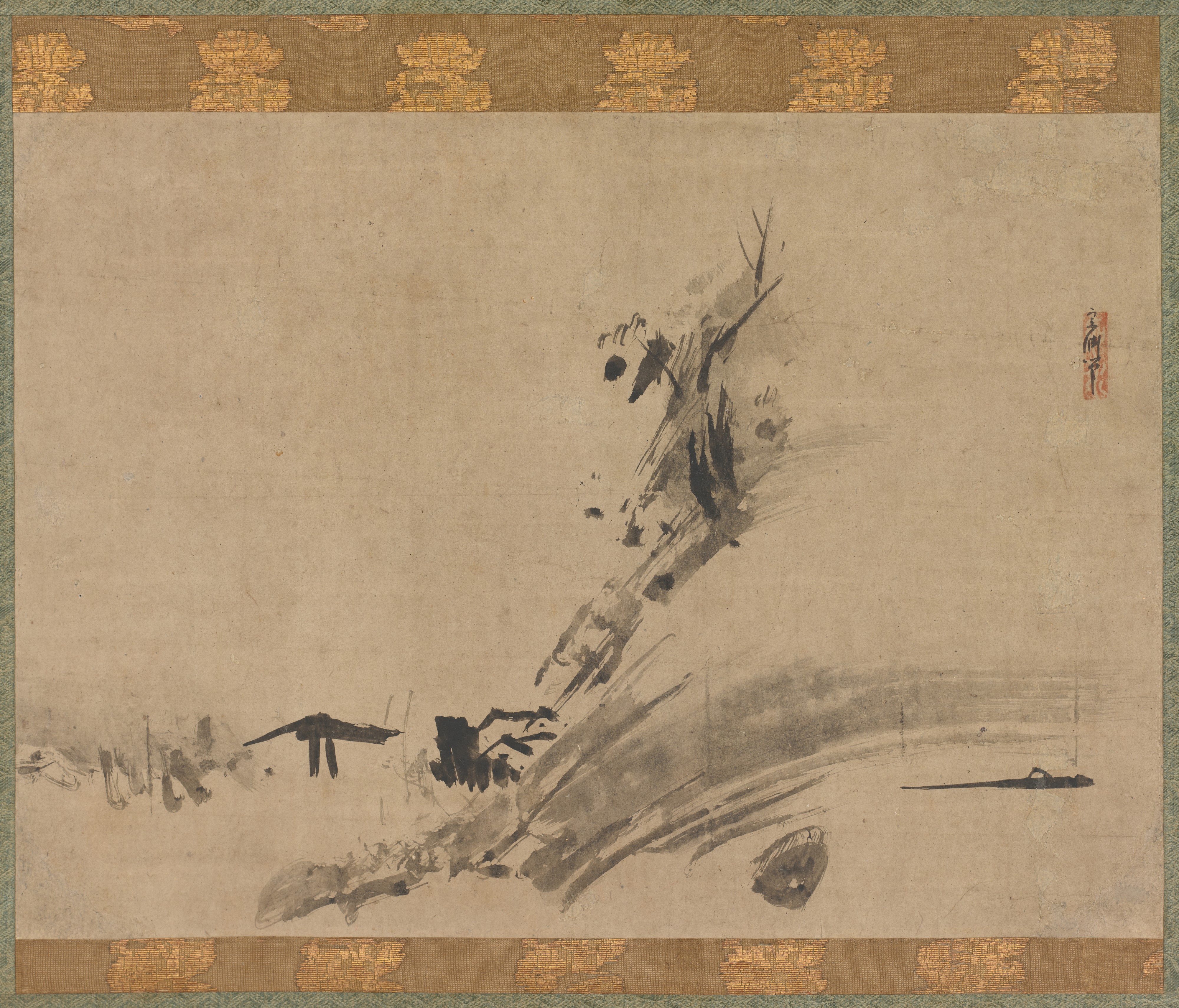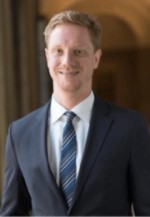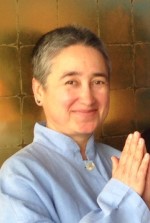 beauty, emotion, and emptiness
accident and intention
The way of the brush
sound of water
beauty, emotion, and emptiness
accident and intention
The way of the brush
sound of water
Move your cursor to explore different voices about the artwork
On your phone:
Click on the different “searchlights” in the interactive to explore the individual responses to the artwork. You can also zoom in on the artwork and view its details.
On your PC:
Use the spotlight to discover points of interest in the artwork. Click on the points to explore the individual responses to the artwork. You can also zoom in on the artwork and view its details.
Narrator (00:01):
Musician Yumi Kurosawa describes this ink painting in musical terms.
Yumi Kurosawa (00:06)):
When I first saw this artwork, I felt the traditional Japanese artistic beauty emotion Ku, or emptiness; Ma, or breathing space; and strength in certain spots. I created this music which connects to those elements and emotions. A little of traditional taste blended with emotional sound in a modern way. Enjoy.

Yumi Kurosawa is an award-winning musician who specializes in the koto, a Japanese stringed instrument. She has performed at the Kennedy Center, Carnegie Hall, and venues across Europe and Asia, and has appeared with the Tokyo Symphony Orchestra, the Hawaii Symphony Orchestra, and the Houston Grand Opera. All About Jazz noted that when she plays, “the koto’s notes flow like the water of a stream in a Zen garden.”
Narrator (00:01):
Look closely at the brushstrokes in this scroll painting with museum curator Frank Feltens.
Frank Feltens (00:07):
This painting here is the kind of work that proliferated very much in Zen circles—actually emerged from the circles of Zen painters—in Japan’s medieval period. How does an abstract painting like this come together? And how does a painter create it? And that is really one of the most interesting aspects of works like these.
Frank Feltens (00:32):
So, at first, the painter takes up their brush, dips it into a pool of ink, and then adds an accidental mark onto the paper, in this case, and builds the composition around that accidental mark in these conglomerations of abstracted strokes of ink that then merge together into a larger whole. And let’s just assume that the painter, Soen, first added that little dot to the lower right on the picture. Let’s just assume that this was the first accidental mark. So then to him, that was probably a rock in a river. Then he decided to add a sweeping—a bunch of sweeping strokes to create a shoreline. Then build up the face of the mountain, and at the foot of it, in darker ink, added a tiny village with a fence. Then on the left side of it, a bridge and a different shoreline left to it. So, after that, he added a little bit more foliage to the mountain side and a boat with a fisherman inside of it, telling us that the negative space is actually water. And here we have this painting.
Frank Feltens (01:54):
Works like these were, actually, as you just saw, conceived as sort of a mixture between accidentality and intention. And that’s exactly the kind of aesthetic that artists like Soen wanted to convey. But they also work with viewer engagements very clearly, in a sense that the viewer is invited to engage with these abstracted lines and merge them in their mind into a visual whole. You are invited to enter this landscape and piece it together in your mind and engage with the painter over time, and with this artistry centuries after this work was made in the early sixteenth century. So, in that sense, these types of splashed-ink landscapes, as they are called, are really reciprocal works in which the viewer and the painter engage in this mediated conversation through the painting itself.
Frank Feltens (02:58):
Just a few words about Soen. Soen was a painter active in the late fifteenth to sixteenth century, and he was based initially in Kamakura. So, not in Kyoto, in the center of power and imperial patronage, but in the eastern city of Kamakura at a famous Zen temple called Engakuji. But then he moved to Yamaguchi, which is in western Japan, to study with the famous, or the most famous, perhaps, ink painter of all, Sesshū. And Soen was such an important pupil of Sesshū that he received one of Sesshū’s perhaps most important paintings, a splashed-ink landscape, not dissimilar to this one, that is now in the Tokyo National Museum, as a certificate of excellence and graduation from Sesshū, signaling that Soen was one of his most cherished pupils, creating a lineage between both of them. And this is why this small splashed-ink landscape here in our collection is so important, because it really draws and continues this lineage between these two great painters in this really mesmerizing mode of Japanese paint.

Frank Feltens is the Japan Foundation Associate Curator of Japanese Art at the National Museum of Asian Art. He is a specialist in Japanese art with a focus on the late medieval and early modern periods, including Japanese photography and the intersections between painting and ceramics. He is co-curator of the exhibition Mind over Matter: Zen in Medieval Japan.
Narrator (00:01):
Rev. Inryū Bobbi Poncé-Barger, a Zen practitioner based in Washington, DC, shares her thoughts on the sense of freedom in this ink painting.
Rev. Inryū Bobbi Poncé-Barger (00:10):
So, one of the reasons I saw this and got excited about it is that I do some shodo myself, which is the way of the brush. So, chado, the way of tea, shodo, the way of the brush. We even have—it’s called kyudo, the way of archery. All of these disciplines or practices have been refined and developed after people do meditative monastic practices. So, this to me represents a master of this particular skill. One of the exciting things to me about it is the freedom in the brushstroke. It takes a lot of skill to break out of constraints as we learn how to do kanji or to communicate in writing to people. The clarity is always the thing that is prominent or the filling of the page.
Rev. Inryū Bobbi Poncé-Barger (01:00):
But in shodo, it’s really much more about the energy of what you are offering in the moment and allowing kind of the idea of the ink and the water and the moment. I mean, even the air moving around the room and the paper to come in together to create something together. So, it’s not just the person holding the brush, it’s sort of a dance between all of those components. But in this case, there is this wonderful kind of sweep that the person has made. And I don’t know if they’re making it, I would guess, from a memory or perhaps from a feeling, but I get the feeling that it’s the real place. I get the feeling that it’s kind of a known place to the person who made it, because I really feel the atmosphere of it. I was thinking that I even feel like there’s, it’s kind of dry, that the air is dry and maybe there’s some wind and it just has this atmosphere.
Rev. Inryū Bobbi Poncé-Barger (01:59):
And then it has that beautiful little, little hut, which could be a little meditation hut to stop at and to sit down at and do some Zazen. I think definitely the hut and the foliage, the trees, were probably added as a second step and just so simple, but just really energetic. One of the things that I showed it to my teacher, and he said, well, this person is really free. At the same time, they’re very grounded, which is exactly what one would seek to have doing any of these arts, but particularly coming off your meditation cushion to be grounded, but to have a liberated expression of yourself would be really beautiful. And so, this person obviously has studied for a long time and felt that capacity to be grounded and free simultaneously.

Reverend Inryū Bobbi Poncé-Barger, Sensei, is the Abiding teacher and resident priest for the All Beings Zen Sangha in Washington, D.C. She is a fully ordained and transmitted priest in the Soto Zen Buddhist lineage of Shunryū Suzuki Roshi (founder of the San Francisco Zen Center). Rev. Inryū serves on the Board of Directors for the Soto Zen Buddhist Association and is a member of the American Zen Teachers Association.
Narrator (00:01):
Penelope Morris and Akesh Mallia, high school students from Washington, DC, share their first impression of this abstract landscape.
Akesh Mallia (00:09):
For me, it was the sharp dark lines in the bottom left that attracted my eye just because they were dark. Also, the other lines that were lighter and more curved, the ones in the bottom left are really dark, short, and jagged, so that caught my eye first.
Penelope Morris (00:28):
The first thing I saw was the part that goes up, I guess because there are also some dark parts on there. Then my eye went to, I think they’re buildings at the lower center part.
Akesh Mallia (00:39):
I kind of followed the lighter lines to the dark area in the top right-ish area. Then I saw the light curve there. A word that comes to mind would be natural and glowing because the lighter lines flow in a certain direction and draw your eye to certain darker areas of the painting.
Penelope Morris (01:01):
I would say empty, but not in a lonely way, more in like a peaceful solitude way because it’s a lot of empty space and so it’s pretty calming. It looks like water in the bottom right corner. I think it would be really calming and peaceful. At least for me, being in nature is always calming and just being in open space. It looks like there’s water, so you could hear the sound of water.
Akesh Mallia (01:31):
Yeah, I agree. I imagine this is somewhere in the natural world. The first thing I thought of when looking at the darker areas was that one of them looks like an animal that’s standing on two legs or something. So, you could probably hear the animals with the water, so I’d imagine it’d be very relaxed.
Penelope Morris (01:48):
I think, I’m not sure, but I think those are buildings, so maybe the sounds of whoever lives there is going about their daily lives.
Akesh Mallia (01:56):
Yeah. Now that I look at it, those actually do look like buildings in the bottom left so yeah, I’d agree. You’d probably hear people going about their lives with the water flowing through it.
Penelope Morris (02:08):
I think I want to ask them, stylistically, why is it so empty? Some of the other art that we looked at was a lot more detailed and elaborate. This is just a few brushstrokes and it has a really cool effect. I’m just wondering what made them paint it that way.
Akesh Mallia (02:25):
I’d probably ask them what they intended to make when they first started drawing this because it looks like a lot of things. Each part of this piece looks like many different things, so yea, that’s what I would ask them.

High School Students from Globalize DC shared their perspectives with the museum. This program focuses on increasing access for DC’s public school students to high quality global education, language learning, and study abroad opportunities. Globalize DC reduces barriers to access for underserved students and schools, supporting sustainable pathways to college and careers in global fields.